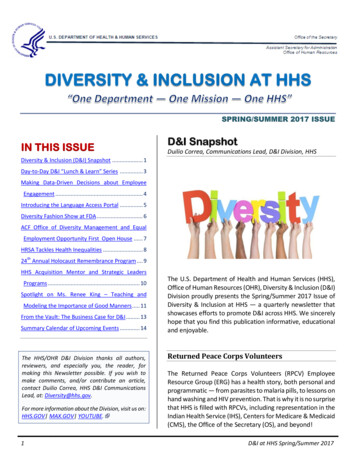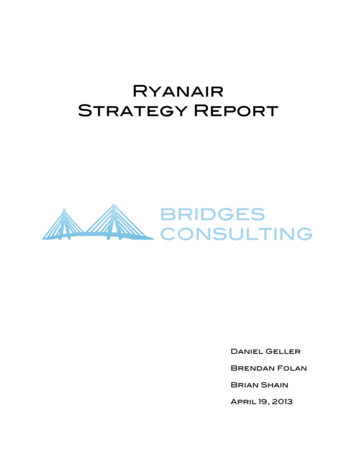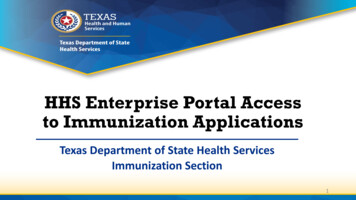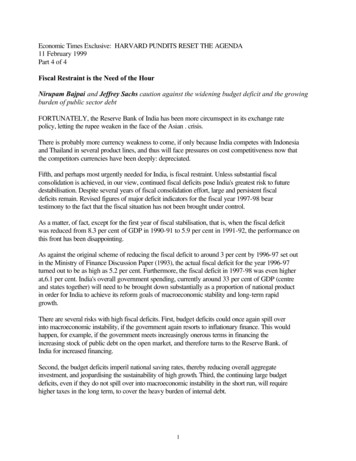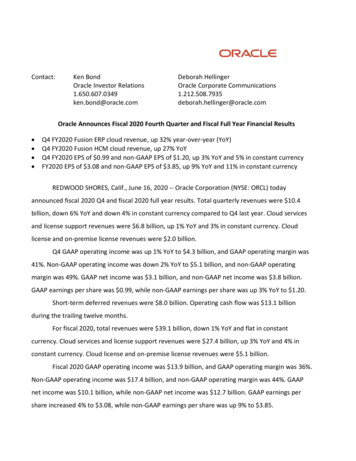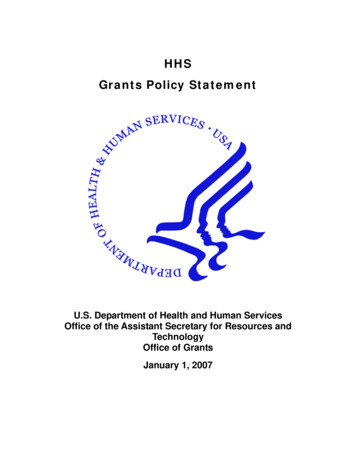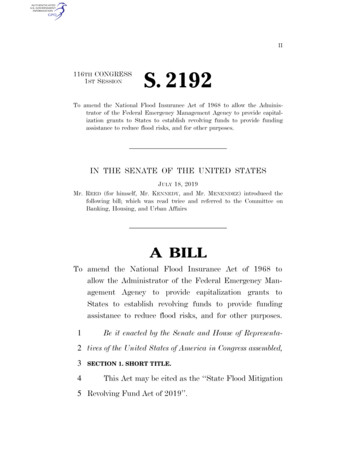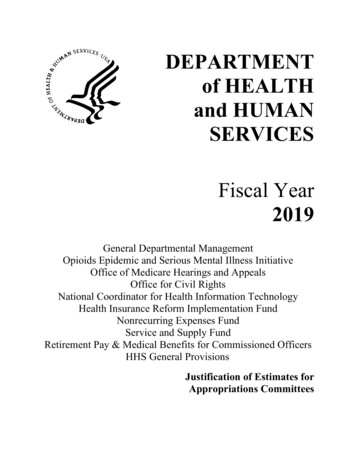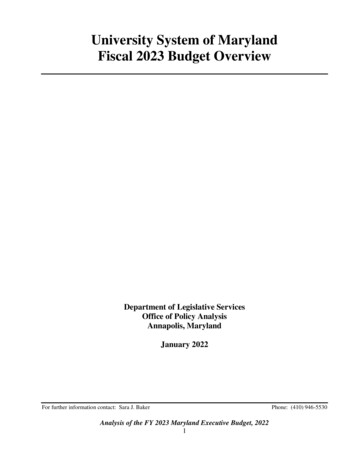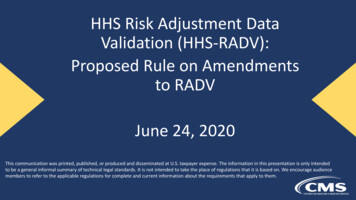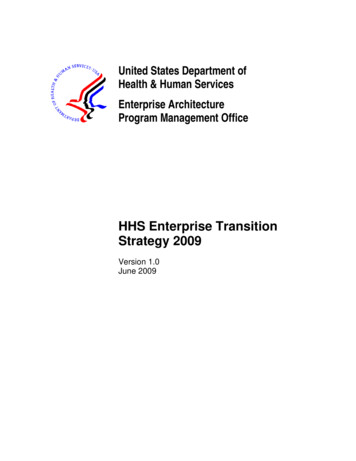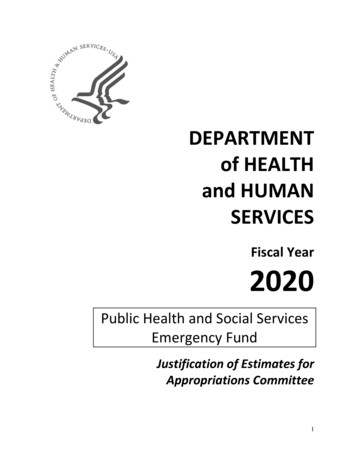
Transcription
DEPARTMENTof HEALTHand HUMANSERVICESFiscal Year2020Public Health and Social ServicesEmergency FundJustification of Estimates forAppropriations Committee1
Public Health and Social Services Emergency FundTable of ContentsORGANIZATIONAL CHARTS . 8INTRODUCTION AND MISSION . 11OVERVIEW OF BUDGET REQUEST . 13OVERVIEW OF PERFORMANCE . 15FY 2020 ALL PURPOSE TABLE . 18FY 2020 PROPOSED APPROPRIATIONS LANGUAGE . 19APPROPRIATIONS LANGUAGE ANALYSIS . 20AMOUNTS AVAILABLE FOR OBLIGATION. 21SUMMARY OF CHANGES . 22BUDGET AUTHORITY BY ACTIVITY. 23AUTHORIZING LEGISLATION . 24APPROPRIATIONS HISTORY . 25APPROPRIATIONS NOT AUTHORIZED BY LAW . 26OFFICE OF THE ASSISTANT SECRETARY FOR PREPAREDNESS AND RESPONSE . 27SUMMARY OF REQUEST. 27PREPAREDNESS AND EMERGENCY OPERATIONS. 30NATIONAL DISASTER MEDICAL SYSTEM. 40CIVILIAN VOLUNTEER MEDICAL RESERVE CORPS . 46HOSPITAL PREPAREDNESS PROGRAM . 51BIOMEDICAL ADVANCED RESEARCH AND DEVELOPMENT AUTHORITY . 73PROJECT BIOSHIELD . 91STRATEGIC NATIONAL STOCKPILE . 96OFFICE OF POLICY AND PLANNING . 104OPERATIONS . 114ASSISTANT SECRETARY FOR ADMINISTRATION . 118CYBERSECURITY . 118OFFICE OF NATIONAL SECURITY. 129PANDEMIC INFLUENZA. 132BUDGET AUTHORITY BY OBJECT CLASS . 145SALARIES AND EXPENSES . 146DETAIL OF FULL-TIME EQUIVALENTS (FTE) . 147DETAIL OF POSITIONS . 1482
Public Health and Social Services Emergency FundWe are pleased to present the Fiscal Year (FY) 2020 Congressional Justification forthe Public Health and Social Services Emergency Fund (PHSSEF). The FY 2020Budget Request directly supports the United States’ ability to prepare for, respondto, and recover from the consequences of a wide range of natural and man-mademedical and public health threats and includes the FY 2020 budget justification forthe Office of the Assistant Secretary for Preparedness and Response (ASPR),Cybersecurity, the Office of National Security (ONS), and the Office of GlobalAffairs pandemic influenza program.Office of the Assistant Secretary for Preparedness and ResponseASPR’s mission at its core is to save lives and protect Americans. On behalf of HHS, ASPR leads thepublic health and medical response to disasters and public health emergencies, in accordance with theNational Response Framework and Emergency Support Function #8. HHS also supports other federalentities who lead Emergency Support Function #6 with respect to human and social services, includingrecovery. ASPR coordinates across HHS, the federal interagency, and supports state, local, territorial,and tribal health partners in preparing for and responding to emergencies and disasters. ASPR alsoenhances medical surge capacity by organizing, training, equipping, and deploying federal public healthand medical personnel and providing logistical support for federal responses to public health emergencies.At the state and local level ASPR supports readiness by coordinating federal grants and cooperativeagreements and carrying out drills and operational exercises. Through coordinating the Public HealthEmergency Medical Countermeasures Enterprise, including the Biomedical Advanced Research andDevelopment Authority (BARDA) and the Strategic National Stockpile (SNS), ASPR oversees advancedresearch, development, procurement, and stockpiling of medical countermeasures (e.g. vaccines,medicines, diagnostics, and other necessary medical supplies).ASPR continues to respond to catastrophic hurricanes and other natural disasters by activating NationalDisaster Medical System (NDMS) personnel to communities impacted by the storms. NDMS isincreasing its intermittent employee workforce towards a goal of over 6,000 personnel organized into 71teams. NDMS currently has 2,941 deployable personnel. Throughout FY 2018, NDMS teams providedpublic health and medical support for the following: California Wildfires, the State of the Union Address,the United Nations General Assembly, the Peace Officer’s Memorial, and ongoing operations in supportof Puerto Rico and the United Sates Virgins Islands response and recovery efforts.NDMS teams include clinical providers and specialized medical service professionals, includingphysicians, nurses, fatality management professionals, paramedics, veterinarians, and other support staff,such as logisticians and information technology specialists. During the natural disaster responses toHurricanes Florence, Isaac, Michael, and Typhoon Yutu in 2018, ASPR deployed over 20 NDMS teamson a rotational basis comprised of more than 2000 employees that treated patients with a wide variety ofillnesses and injuries. ASPR’s actions saved lives, stabilized the healthcare system, and restored services.ASPR must support health care coalitions, medical providers, and emergency managers in preparing forincidents that impact medical and public health capabilities.In addition, when an infectious disease outbreak occurs, the public expects immediate access to vaccines,diagnostics, and drugs as was seen during the 2009 H1N1 pandemic and the 2013 Ebola virus epidemic inAfrica. To meet this public demand, protect health, and save lives in the next pandemic or diseaseepidemic, the federal government must continue to take action and maintain momentum to develop newmedical countermeasures–vaccines, drugs, diagnostics, and devices–so they are available immediatelywhen needed. Enhanced partnerships with small and large companies, sustained investments madepossible under Project BioShield (PBS), and funding provided for Pandemic Influenza preparedness overthe last decade have successfully led to new capabilities, including medical countermeasures critical to3
Public Health and Social Services Emergency Fundnational health security. These advances continue to boost the nation’s readiness to respond to the medicalconsequences of anthrax, botulism, smallpox, radiological and nuclear agents, chemical agents, andemerging diseases. The medical countermeasure pipeline holds more promise today than ever to combatlong-standing threats and newly emerging ones.ASPR’s advanced research and development program bridges gaps in national preparedness that no otherfederal agency does: the late stages of development necessary to reach licensure of medical products thatprevent, diagnose, or treat illnesses or injuries from chemical, biological, radiological, and nuclear threats,as well as from emerging infectious diseases and the growing public health threat of antimicrobialresistance. All of these threats pose a dire threat to American and global health. BARDA, in partnershipwith industry, has built a robust and formidable pipeline for advanced research and development ofmedical countermeasures. These efforts focus on combatting the medical consequences of 13 chemical,biological, radiological and nuclear threats identified by the Department of Homeland Security (DHS).These advanced development programs have supported 27 products that have transitioned to supportunder Project BioShield; 15 of these products have been procured for the Strategic National Stockpile(SNS).BARDA strategically supports advanced development and acquisition of medical countermeasures thatare existing products that can be repurposed to meet medical countermeasure needs or new multipurposeproducts with commercial indications that meet public needs. This approach increases the sustainabilityof these medical countermeasures and provides alternate mechanisms (e.g., vendor managed inventorysystems) to stockpiling in the SNS.Pandemic Influenza funding supports HHS’s efforts to prepare for and respond to a pandemic influenzaoutbreak. These funds support the development of next-generation antivirals, ongoing activities topromote the development of rapid diagnostic assays for the diagnosis of pandemic influenza, and theaccelerated development and production of influenza vaccine worldwide. During 2018, BARDAcontinued to support expansion of domestic adjuvant manufacturing capacity. This effort includes bothbulk adjuvant manufacturing as well as fill/finish capability. Additional efforts during 2019 and 2020,contingent upon available funding, will look to further improve adjuvant manufacturing capacity andfill/finish capability. Once completed, these efforts will ensure a ready supply of adjuvant in the event ofa pandemic. In 2018, BARDA collaborated with the Department of Defense (DoD) to re-evaluate both theCIADMs and the DoD’s advanced development and manufacturing (ADM) facility at Ology.To improve America’s readiness against national disasters, including naturally or man-made diseasethreats, ASPR has acquired the SNS and is engaging in the procurement, maintenance, and deployment ofmedical countermeasures. The addition of the SNS to ASPR improves overall emergency responseoperations providing health and medical services to communities in need. Efficiencies across the medicalcountermeasure enterprise are expected. In coordination with the Public Health Emergency MedicalCountermeasures Enterprise, the SNS will develop strategies to meet the national priorities for federalstockpiling and to maintain and improve SNS capabilities as well as address inventory gaps. Throughthis, the enterprise will be more sustainable, productive, and effective at developing, stockpiling, anddeploying the medical countermeasures needed to save lives and protect America from 21st Centuryhealth security threats. Under ASPR, the SNS will make meaningful investments across a spectrum ofthreats, including antibiotics to treat anthrax exposure; antivirals to treat pandemic influenza; andvaccines and therapeutic drugs to protect against smallpox. At the requested funding level, the SNS, inFY 2020, will replace the highest priority expiring medical countermeasures held in inventory. Therequested funding level ensures SNS assets are available and ready for use to protect America from 21stcentury health security threats in FY 2020 by: managing, storing, maintaining, and replacing MCMassets, valued at nearly 7 billion; supporting PHEMCE with subject matter expertise and data to informstrategic MCM requirements and procurement decisions; establishing and strengthening public-private4
Public Health and Social Services Emergency Fundpartnerships to integrate private resources into public health response plans for a fully functioning supplychain for delivery of critical MCMs; and, providing timely, accurate, and relevant information toclinicians to respond to emerging threats and public health emergencies.HHS and ASPR have made significant progress since its inception in 2006. To further improve nationalreadiness and response capabilities, four key priority areas have been identified:Goal 1 – Provide strong leadership. ASPR is a leader in both preparedness for and response to 21stcentury health security threats. ASPR provides clear policy direction, and improved threat awareness,while continuing to secure adequate resources to manage the next health threat. ASPR will continue tocoordinate with public health agencies as well as the Director of National Intelligence and the Departmentof Homeland Security to address current and future national security threats.Goal 2 – Support Regional Disaster Health Response Capabilities. To address the potentialcatastrophic medical consequences of 21st century threats, a regional approach to improve national healthcare readiness and medical surge capacity is needed. Supporting regional disaster health responsecapabilities will require collaboration among existing local healthcare coalitions, trauma centers, publicand private health care facilities, and emergency medical services. This may be accomplished byintegrating preparedness within the already-existing health care delivery infrastructure across the publicand private sectors and increasing coordination with non-government entities, including private sectorhospitals and health care providers. Ultimately, this approach will better support state, local, tribal, andterritorial (SLTT) disaster risk reduction, preparedness, mitigation, response, and recovery efforts.Goal 3 – Sustain robust and reliable public health security capabilities. ASPR supports public healthagencies’ ability to quickly detect, diagnose, monitor and respond to 21st century health threats. This iscritical to rapidly and effectively dispense MCMs in an emergency. ASPR has responsibility for theStrategic National Stockpile and the “last mile” of MCM distribution and dispensing, in coordination withCDC.Goal 4 – Advance an innovative medical countermeasures enterprise. Since 2006, ASPR’sBiomedical Advanced Research and Development Authority (BARDA) has supported the advancedresearch and development of new MCMs. By using flexible, nimble authorities, multi-year advancedfunding, strong public-private partnerships, and cutting-edge expertise, BARDA has successfullyadvanced 43 innovative products to the Food and Drug Administration for approval. ASPR will continueto develop and maintain a robust stockpile of MCMs capable of responding to 21st century health threats.The FY 2020 budget request for ASPR is 2,587,019,000, which is 25,900,000 above the FY 2019Enacted level. The request provides: 1.3 billion for BARDA, including 562 million for Advanced Research and Development, and 735 million for Project BioShield procurements of MCMs; 260 million for pandemic influenza preparedness activities by ASPR and the HHS Office ofGlobal Affairs; 620 million for the Strategic National Stockpile (SNS) to manage and deliver life-savingmedical countermeasures during a public health emergency;5
Public Health and Social Services Emergency Fund 258 million for the Hospital Preparedness Program to support cooperative agreements with state,local, and territorial health departments to improve surge capacity and enhance communityhealth care coalitions; 106 million for public health and medical preparedness and emergency operations, the NationalDisaster Medical System, and the Civilian Volunteer Medical Reserve Corps; and, 51 million for ASPR’s policy, planning, acquisitions, grants, financial management,administrative operations, and executive leadership.CybersecurityThe HHS Cybersecurity program maintains the security of an array of unique systems and sensitive datawithin the Department. To meet its mission, HHS maintains a vast array of secure information. TheDepartment awards more grants than any other Federal agency, requiring systems in place to keep suchfinancial data secure. Additionally, the Department’s systems are utilized across the Federal Governmentand maintain sensitive data, including personally identifiable information, health records, sensitivebiodefense research, and proprietary data. The Budget Justification supports, sustains, and enhances theDepartment’s security posture to support a more nimble and flexible operating level. The activitiessupported in the Budget will address ongoing Cybersecurity concerns and prepare for the futurechallenges that accompany rapidly changing technologies. The Department continues to assess evolvingrequirements and support for HHS specific needs as cyber threats becoming increasingly complex.The Cybersecurity Program is tasked with implementing a comprehensive, enterprise-wide cybersecurityprogram to protect the critical information with which the Department is entrusted. The FY 2020 budgetrequest for Cybersecurity is 68 million, which is 9.233 million above the FY 2019 Enacted level. Therequest will prioritize: Implementing specific cybersecurity capabilitiesCultivating cybersecurity partnerships in the public and private sectorsEngaging in HHS-wide security collaboration activitiesEnhancing HHS’ security capabilities through current and future programs and projectsOffice of National SecurityThe Office of National Security (ONS), formerly known as the Office of Security and StrategicInformation (OSSI), provides strategic all-source information, intelligence, counterintelligence, insiderthreat, cyber threat intelligence, and special security (classified information) and communications securitysupport across the Department– all of which are resourced with PHSSEF funds. ONS is also responsiblefor the Department’s personnel security programs; these are resourced by non-PHSSEF funds. ONSprogram objectives include increasing the Department’s security and threat awareness and its ability torespond swiftly and effectively to national and homeland security threats, as well as to respond to publichealth emergencies. These objectives are achieved by ONS’s continued engagement internally andexternally with Federal partners and others, its ability to analyze all-source intelligence/information toidentify potential threats and vulnerabilities, and its ongoing programs that identify and assess trends andpatterns across the Department while developing and implementing mitigation strategies.ONS is responsible for the safeguarding of all classified information, equipment and facilities across theDepartment and is HHS’s Federal Intelligence Coordination Office (FICO) and Secretary’s SeniorIntelligence Official. The FY 2020 budget request includes 7 million for ONS, remaining flat with theFY 2019 Enacted level.6
Public Health and Social Services Emergency FundAs learned through public health threats such as Ebola and Zika, it is critical for the Department torespond quickly when such threats arise. To enable a swift response to emerging public health threats thathave significant potential to affect the health and security of U.S. citizens, the FY 2020 Budgetre-proposes the establishment of a new transfer authority within the Office of the Secretary. HHS wouldhave Department-wide transfer authority to help bridge the Department’s response in situations thatexceed the planned scope of emergency preparedness and response programs and activities.Eric HarganHHS Deputy SecretaryRobert P. KadlecAssistant Secretary for Preparednessand Response, Ph.D.Janet VogelHHS Chief Information Security OfficerMichael SchmoyerAssistant Deputy Secretary forNational Security, Ph.D.7
ORGANIZATIONAL CHARTSOFFICE OF THE ASSISTANT SECRETARY FOR PREPAREDNESS AND RESPONSEAssistant Secretaryfor Preparednessand urity, g, Policy,RequirementsChief of StaffPrincipal DeputyAssistantSecretaryManagement,Finance, HumanCapitalEmergencyManagement,Medical Stockpile8
CYBERSECURITYChief InformationSecurity Officer (CISO)Janet Vogel SESDeputy Chief InformationSecurity Officer (DCISO)Chris Bollerer (Acting)Healthcare Sector SecurityAdvisorCybersecurity TechnologyAdvisorCybersecurity OperationsJames AntonucciSecurity SystemsSupportBob BarczynskiTICTravis RichardsonHC3Greg SingletonCSIRCGregory Rich (A)Business OperationsEddie BlankenshipOffice of the SecretaryCybersecurity (OS)Julia WhiteCybersecurity ServicesChris BollererCybersecurity GovernanceVacantIncident ResponseVacantInformationAssuranceCybersecurity RiskManagementJulie ChuaCybersecurity ComplianceVacantEnterprise SecurityServicesHTOCWilliam WelchResearch andForensics9
Public Health and Social Services Emergency FundOFFICE OF NATIONAL SECURITYAssistant Deputy Secretary forNational SecurityCAPT Michael Schmoyer, PHSDeputy DirectorLisa AguirreIntelligence and AnalysisDivisionAlisa HudgensDivision ofOperationsLisa Aguirre, ActingPersonnel SecurityDivisionSonya SargentOliverBusinessManagementKim Bannister,Acting10
Public Health and Social Services Emergency FundINTRODUCTION AND MISSIONThe Public Health and Social Services Emergency Fund supports the Department’s cross-cutting effortsto improve the nation’s preparedness against naturally occurring and man-made health threats and threatsto the ability of HHS to carry out such missions. The following programs are supported by this Fund:Assistant Secretary for Preparedness and Response:The Office of the Assistant Secretary for Preparedness and Response (ASPR) mission is to save lives andprotect Americans from 21st century health security threats. These threats include natural disasters,pandemic diseases, and man-made threats from chemical, biological, nuclear, and radiological (CBRN)agents. ASPR coordinates across HHS and the Federal interagency to support state, local, territories, andtribal health partners in preparing for and responding to emergencies and disasters.The ASPR serves as the principal advisor to the Secretary on public health and medical emergencypreparedness and response, including incidents covered by the National Response Framework. ASPRtakes a collaborative approach to the Department’s preparedness, response, and recovery responsibilitiesby working with Operational Divisions and Staff Divisions across the Department to coordinatepreparedness and response activities. In addition, ASPR has operational responsibilities for the advancedresearch and development and the stockpiling of medical countermeasures (MCMs) and for thecoordination of the Federal public health and medical response to such incidents.The strength of our nation’s public health and medical infrastructure, as well as the capabilities necessaryto quickly mobilize a coordinated national response to pandemics, attacks and disasters, are essential tosave lives and protect all Americans.Cybersecurity:The Cybersecurity program, within the Office of the Assistant Secretary for Administration, coordinatesall of the HHS information technology security efforts and works to ensure that automated informationsystems are designed, operated, and maintained with the appropriate information technology security andprivacy protections. The Budget Justification supports, sustains and enhances the Department’s securityposture and helps support a more nimble, flexible operating level to address ongoing Cybersecurityconcerns and to prepare for the future challenges that accompany rapidly changing technologies. TheDepartment continues to assess evolving requirements and support for HHS specific needs as cyberthreats becoming increasingly complex.Office of National Security:The Office of National Security (ONS), formerly known as the Office of Security and StrategicInformation (OSSI), provides strategic all-source information, intelligence, counterintelligence, insiderthreat, cyber threat intelligence, and special security (classified information) and communications securitysupport across the Department– all of which are resourced with PHSSEF funds. ONS is also responsiblefor the Department’s personnel security programs; these are resourced by non-PHSSEF funds. ONSprogram objectives include increasing the Department’s security and threat awareness and its ability torespond swiftly and effectively to national and homeland security threats, as well as to respond to publichealth emergencies. These objectives are achieved by ONS’s continued engagement internally andexternally with Federal partners and others, its ability to analyze all-source intelligence/information toidentify potential threats and vulnerabilities, and its ongoing programs that identify and assess trends andpatterns across the Department while developing and implementing mitigation strategies. ONS isresponsible for the safeguarding of all classified information, equipment and facilities across the11
Public Health and Social Services Emergency FundDepartment and is HHS’s Federal Intelligence Coordination Office (FICO) and Secretary’s SeniorIntelligence Official.Pandemic Influenza:Pandemic Influenza funding supports HHS’s efforts to prepare for, and respond to, a pandemic influenzaoutbreak. These funds support the development of next-generation antivirals, ongoing activities topromote the development of rapid diagnostic assays for the diagnosis of pandemic influenza, and theaccelerated development and production of influenza vaccine worldwide.12
Public Health and Social Services Emergency FundOVERVIEW OF BUDGET REQUESTThe FY 2020 Request for the Public Health and Social Services Emergency Fund (PHSSEF) is 2,666.591 million, which is an increase of 35.133 million relative to the FY 2019 Enacted level. Thefunds requested will provide the necessary resources to: Support a comprehensive program to prepare for and respond to the health and medicalconsequences of bioterrorism and other public health emergencies;Maintain the Department’s counter-intelligence program;Maintain the Department’s cybersecurity efforts; andSupport the Department’s pandemic influenza preparedness and response activities.The Budget provides funds within the Office of the Secretary, and specifically for the Office of theAssistant Secretary for Preparedness and Response (ASPR) and the Office of the Assistant Secretary forAdministration (ASA). This justification also requests funding for the Department’s cybersecurity andpandemic influenza activities.Programmatic Increases (relative to the FY 2019 Enacted):National Disaster Medical System (NDMS) (increase of 20 million, 77.404 million total): Therequest supports continued NDMS operations, logistics support, and regional emergency coordination, toprepare and respond to public health emergencies and disasters. Funding will be utilized for medicalresponse assets, including training for NDMS teams, and modernized equipment sets. This increase willsupport the pediatric disaster care pilot initiative.Strategic National Stockpile (SNS) (increase of 10.0 million, 620.000 million total): Thisincreased investment will allow ASPR to replace the highest priority expiring SNS countermeasures inFY 2020. Product procurement in FY 2020 will be guided by existing guidance and recommendationsfrom The Public Health Emergency Medical Countermeasures Enterprise (PHEMCE). ASPR willcoordinate PHEMCE activities to develop strategies to meet the national priorities for federal stockpilingand to maintain SNS capabilities and address inventory gaps.Cybersecurity (increase of 9.233 million, 68.093 million total): Funding will support necessaryactivities to protect the Department’s information technology systems. The investment will support thesafeguarding of personally identifiable information, commercial proprietary data, and scientific researchof National importance.Policy and Planning (increase of 5 million, 19.877 million total): The request supports thedevelopment of strategic and operational plans to implement national preparedness functions and preparefor HHS’s response during events. The increase will include 5 million in no-year funding to support theimplementation of the National Biodefense Strategy.Programmatic Decreases (relative to
health security threats. Under ASPR, the SNS will make meaningful investments across a spectrum of threats, including antibiotics to treat anthrax exposure; antivirals to treat pandemic influenza; and vaccines and therapeutic drugs to protect against smallpox. At the requested funding level, the SNS, in
